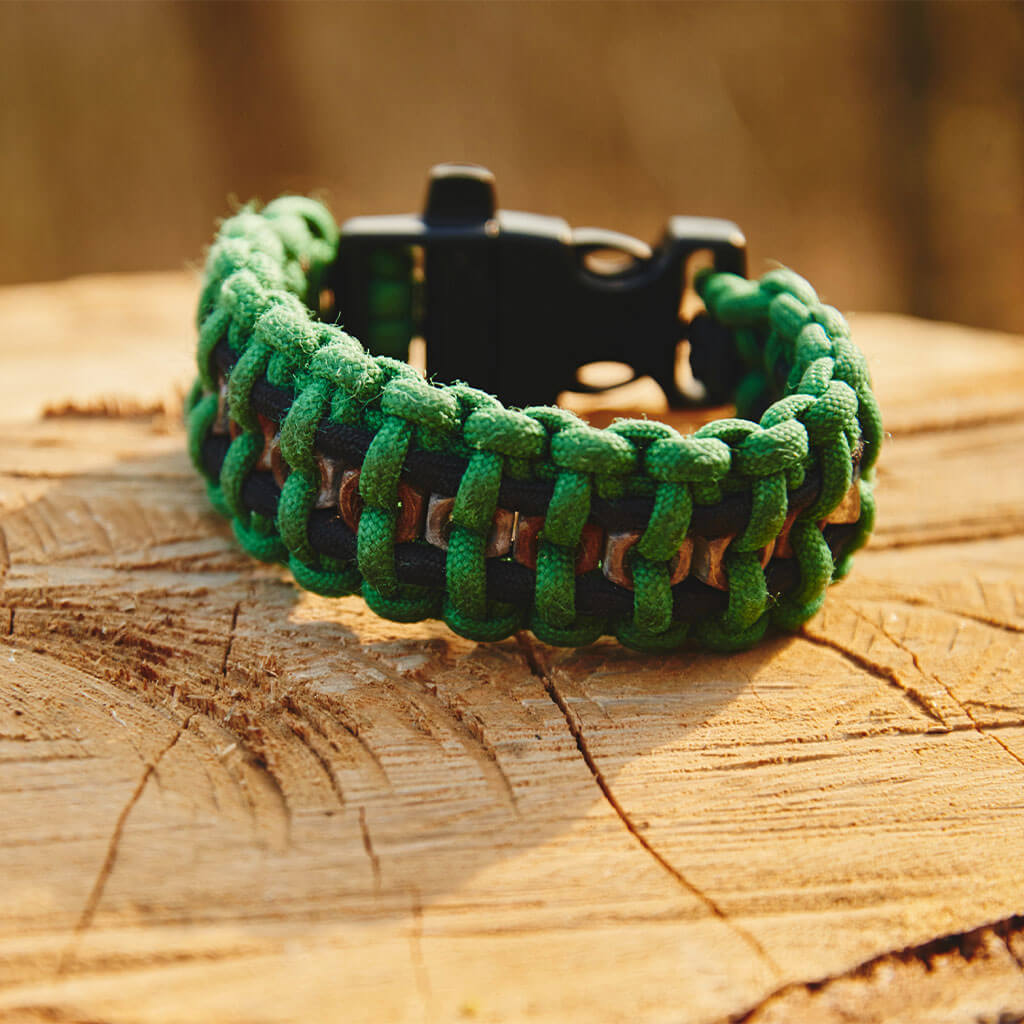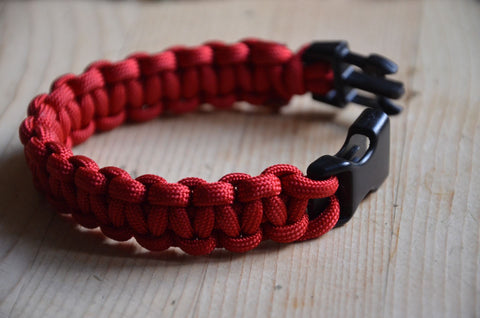Inspired for an Adventure? Check out Beef Stroganoff - Pouch and Beef Stew - Pouch
Free Ground Shipping On All Orders
Over 2,100 Reviews
Add description, images, menus and links to your mega menu
A column with no settings can be used as a spacer
Link to your collections, sales and even external links
Add up to five columns
Add description, images, menus and links to your mega menu
A column with no settings can be used as a spacer
Link to your collections, sales and even external links
Add up to five columns


Have you ever seen one of those hardcore backwoods folks or emergency preparedness enthusiasts sporting a woven cobra bracelet? Chances are, it’s not simply a fashion accessory: it’s a don’t-leave-home-without-it survival tool called a paracord bracelet. Whether you’re faced with a task that calls for finesse or heavy-duty gruntwork, this survival tool could come in mighty handy.
And speaking of handy, there’s no more convenient way to lug around a useful length of 550 cord than as a bracelet. Slip it on your wrist for your next camping trip, and you’ll quickly forget it’s there—until you actually need it for something, in which case you’ll be glad you included this unassuming-looking accessory as part of your backcountry survival gear. So, want to dive in and learn more? Here we go!
What Is A Paracord Bracelet?

Also known as "survival bracelets," "550 cord bracelets," or "parachute cord bracelets," paracord bracelets consist of lightweight nylon woven cords twisted together to be able to handle heavy loads. Small but mighty, they’re a multi-tool of choice by campers, climbers, hikers, survivalists, military soldiers, and outdoor enthusiasts due to their extreme handiness and versatility in emergency situations.
These bracelets can be unraveled to provide a strong, durable cord that can be used for various reasons including securing gear, building shelters, or as a first aid material. We’ll talk much more about their purpose and why they’re so popular throughout the rest of this article, but know that their survival uses are just about endless.
Different Types
A paracord survival bracelet could be made of several different kinds of paracord. Learning the basics of telling apart this cordage isn’t getting too down in the weeds: it’s essential for making sure you’ve got paracord material that’ll reliably serve your needs, whether it’s just as a once-in-a-blue-moon survival backup tool or a regular part of your prepping practice or bushcraft.
Here’s a quick breakdown of the main kinds and categories of paracord and some of their important attributes:
- Type I Paracord: Boasts a minimum breaking strength of 95 pounds and a single core yarn. Comparatively inexpensive.
- Type II Paracord: Uncommon. Minimum breaking strength of 400 pounds, and four to seven yarns within.
- Type III Paracord: The go-to paracord for most outdoor users and survivalists, for good reason: strong, versatile, and affordable. Minimum breaking strength of 550 pounds—the derivation of the common shorthand name of "550 paracord." Seven to nine core yarns.
- Type IV Paracord: Exceptionally strong cordage, with a minimum breaking strength of 750 pounds and 11 core yarns. Significantly pricier than 550 paracord, and for the most part not necessary for the average outdoor recreationist or prepper.
“MILITARY-SPEC” VS “COMMERCIAL-SPEC” 550 PARACORD
It’s also worth it to understand "military-spec" vs "commercial-spec" 550 paracord.
Authentic military-spec paracord should be made entirely of nylon, with seven three-ply yarns.
Commercial-spec paracord may have the same composition, but they also may be single- or double-ply, and the inner strands may be polyester instead of nylon. Depending on your needs, commercial-spec paracord may be perfectly acceptable. However, polyester threads won’t bond with nylon, so commercial-spec paracord that incorporates both of those plastic materials has less all-around utility than a 100% nylon (or, less desirably, a 100% polyester) length of cord.
What’s in Paracord?
Paracord consists of an outer sheath that contains several inner yarns, each composed of up to three strands. Nylon is the traditional material employed in paracord, but as we’ve already mentioned, polyester is also used.
Does Paracord Stretch?
High-quality paracord, such as military-spec cordage, should be able to stretch by a minimum of 30 percent. Keep in mind that a strand of paracord under a sustained load will eventually be subject to “creep,” or permanent stretching; this can be combated by doubling or tripling up the cordage.
How Long Is A Typical Paracord Bracelet?
You can never really have too much paracord, but survival bracelets generally include 20 or more feet of paracord. The length can vary depending on your ability to fashion a longer piece of rope or string in a compact, space-efficient way. Knotting or melt-fusing individual strands can help create a longer bracelet meaning you’ll have a more useful amount of cord at the ready.
Why Do Soldiers Use Paracord Bracelets?
Paracord gets its name from “parachute cord,” which suggests its widespread historical use (particularly during the Second World War) by the military as suspension lines for parachutes. But soldiers quickly found many different ways to use this versatile cordage, including for boot laces, rigging items to pack exteriors, erecting emergency shelters, and securing loads.
Paracord remains popular in the military for the same reasons it’s beloved by survivalists and outdoors people: the possibilities of using it for practical and emergency purposes out in the field are just about endless.
Can I Shower With My Paracord Bracelet?
You can indeed shower with your paracord bracelet on. Paracord will shrink a little the first time it gets wet, and then will stabilize. Before braiding paracord into a bracelet, it’s not a bad idea to “pre-shrink” it by soaking it briefly in hot water and then allowing it to thoroughly dry.
What Are Paracord Bracelets Used For?

It wouldn’t be difficult to rack up a list of dozens of practical uses for paracord, but we put together ten ways to use it that really showcase how utilitarian and versatile a survival bracelet can be for any outdoors person or prepper.
- Wilderness first aid
- Catch a fish
- Make a survival snare
- Build a survival shelter
- Make repairs
- Raise a bear bag
- Fashion a lanyard
- Start a fire
- Suspension lines & tripwires
- Boating uses
We provide detail on how paracord helps in each of these scenarios below.
1. Wilderness First Aid

Among the chief survival bracelet uses is as first-aid material. For instance, you can use paracord to fashion a sling in order to stabilize an injured shoulder, arm, or collarbone, or to apply a splint to a fractured, dislocated, or otherwise banged-up limb.
If you need to transport a wounded or sick person you can also use paracord to create a readymade stretcher by stringing it in a web pattern between a pair of straight and sturdy branches. Here are additional ways to use paracord in your outdoor survival kit:
PARACORD USES FOR FIRST AID
- Tourniquet: In last-resort situations, you can use paracord as an emergency tourniquet by knotting it above a wound and tightening it until the bleeding stops.
- Splint: Stabilize an injured limb or joint using soft padding and a rigid object such as a length of pole or a stout branch, all secured with paracord.
- Sling: You can readily create a makeshift sling by looping paracord around the back of the neck and tying it to the wrist and elbow—just make sure to use some padding between the cord and the injured person’s neck to prevent chafing.
- Stretcher: Transport an injured person by tying paracord lengths between two poles or, if those aren’t available, try creating a stretcher entirely made of cord using a webbing structure.
2. Catch a Fish
Unsheath the paracord’s inner kerf strands, and you’ve got a go-to fishing line: all you need is a hook, some suitable bait, and some patience.
Conversely, you could also fashion a gillnet to snare a finned meal. Use two ropes of paracord for the top and bottom lines—the floatline and the leadline, respectively—and string some of the inner yarn between to form a mesh. The gaps need to be large enough for a fish’s head to enter but too narrow for the body to pass through. You can use chunks of wood as floats and stones as anchors for the leadline; more paracord comes in handy for securing these to the gillnet.
*Please note, we are talking about a survival situation here: obviously, you otherwise should be abiding by any and all angling regulations.
3. Make a Survival Snare

The same applies here: by no means are we advocating going off and snaring woodland creatures just for fun. If you’re staring down an emergency type of situation, however, and you’ve run out of Mountain House meals, you might try your hand at building a survival snare for squirrels, rabbits, and other small quarry using paracord’s inner yarn.
4. Build a Survival Shelter
Among the many other things to do with paracord? Put a roof over your head in a survival situation. Whether you’re rigging a mainline for a tarp or lashing together branches or boughs to make a lean-to, the cord—wielded with a firm knowledge of basic knots, of course—helps you quickly construct an emergency shelter if the weather turns grim or if you need a safe, secure spot to tend to an injured member of your party.
5. Make Gear Repairs

The inner yarn of a piece of paracord makes the perfect in-a-pinch thread for sewing up rips in garments, backpacks, and other equipment.
6. Raise a Bear Bag
If you’re camping in bear country—and given the American black bear’s re-expanding range, that applies to much of North America—it’s vital that you secure your foodstuffs, trash, and toiletries from the shaggy bruins. That means either packing along a bear-proof canister (required in more and more national parks, particularly those with grizzlies, and essential if you’re camping above timberline or anywhere else suitably tall trees are few and far between) or using that paracord bracelet of yours to hoist a bear bag off the ground.
This can actually be more complicated than it sounds: you need to string the bag such that it’s at least 12 feet off the ground and 6 feet or more away from the closest tree trunk or bough. That means finding a tall-enough tree with a long-enough branch or two trees close enough together to string a line between but clear of intervening branches. And make sure you hang the bag 100 feet or more from your campsite, just in case its odors attract a snuffling (and ultimately frustrated) bear.
7. Fashion a Lanyard

Perhaps you’re traversing a particularly confusing stretch of country, or you’re lost and attempting to scout your surroundings along exact bearings so you’re able to return to your original location if need be. If you want your compass close at hand for such tricky navigation work, use a length of paracord to tie it around your neck for easy access.
8. Start a Fire
You can use paracord in a few different ways to get an emergency fire going. Separate out the inner strands and use these as tinder, for example. Some paracord companies actually include especially flammable strands as part of the core.
Alternatively, you can use paracord to work a bow-drill-style fire starter (just be patient).
9. Suspension Lines & Tripwires

Not just for parachutes—you can use paracord for suspension lines in any number of bushcraft contexts. If you feel the need to secure your camp from intruders, you can also rig up some perimeter tripwire by tying paracord at shin height between trees. You could even incorporate some bells, metal utensils, or other noise making items with the tripwire to set up a rough-and-ready alarm system.
10. Boating Uses
Paracord is a handy rope to have in your watercraft, and not just to create some fishing line in a pinch! You can also use it for temporary mooring, to tow an object, or to throw a floundering person a literal lifeline.
Quick Tip: How to Untie Paracord Bracelets
More than a few survival-bracelet wearers have been a little unsure on the best way to actually unbraid one. Some bracelets have a quick-release knot, while others are a bit more complicated: you may need to use a knife blade, a pair of pliers or scissors, or some other tool to wedge out the melted rope ends.
DIY Paracord Projects
The myriad uses of paracord extend to DIY craft projects that join together fun and practicality. You can, for example, test your paracord braiding skills to make your own survival bracelet, lanyard, or belt.
Another at-home paracord project with real value is fashioning a self-defense keychain that incorporates a so-called “monkey fist.” Also colorfully known as a “Celtic slammer,” this involves a steel ball, round stone, or other heavy object wrapped tightly in a paracord ball and wielded with a sufficient length of cord to protect oneself from an attacker.
A Little Paracord Bracelet History

Image by Paracordstyle from Pixabay
We already talked about the origins of paracord as a military-grade parachute cord during World War II—and the many secondary uses soldiers found for the cordage, including snug, rugged boot laces.
But, paracord’s save-the-day uses haven’t only been restricted to Planet Earth. In 1997, astronauts upgrading the Hubble Space Telescope discovered breaches in the unit’s protective insulation. Forced to improvise with some input from Mission Control, they patched the holes using paracord along with wire, plastic ties, and other tools on hand.
Paracord Bracelets: A Camper's Best Friend

Image by Paracordstyle from Pixabay
As we alluded to at the start of this piece, we’ve only sketched out a few of the many possible survival bracelet uses. Paracord is an important addition to add to your outdoor emergency preparedness kit, right alongside your emergency survival foods.
Wondering what other essential items you should take on your backcountry adventure? Read our post on 10 essential supplies you don’t want to forget on your next camping trip.

How to Rotate Emergency Food: FIFO and Other Rotation Methods

The First 72 Is on You: Survival Kit Checklist + Printable PDF


Stay Hungry for Adventure
Sign Up for Delicious Outdoor Meals & Exclusive Offers!
By clicking ‘Join Now’, I agree to the Terms of Service and Privacy Policy.


Join the adventure
©2025 Mountain House — All Rights Reserved.
Your Cart is Empty
Continue ShoppingYour Cart
Subtotal
$0.00
EXPRESS PAYMENT METHODS AVAILABLE IN CHECKOUT
Taxes and Shipping Calculated at Checkout
Your ExpertVoice deal.
$[Deal Price]
$[Original Price]
Discount applied at checkout.
On sale now — lower than your ExpertVoice discount.
Not eligible for ExpertVoice discount.














